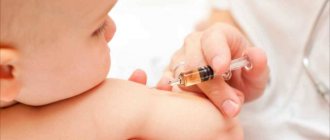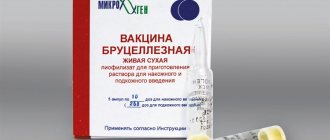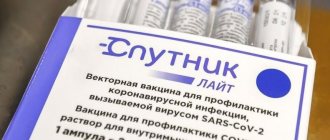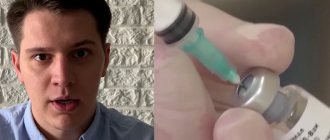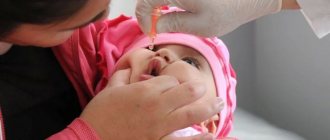Starting from an early age, you can get vaccinated against pneumonia. There are several varieties of it. Like any other vaccine, it can cause complications, but this happens when a person has contraindications to immunization. You need to understand that pneumonia is a deadly disease, and a vaccine can save lives.
Particularly dangerous is pneumonia caused by pneumococci. The disease spreads quickly as it is transmitted by airborne droplets. Moreover, it is almost impossible to isolate the source of infection. Once in the body, pneumococci most often cause pneumonia, although damage to other organs cannot be ruled out. These bacteria can cause otitis media, meningitis, endocarditis and even sepsis.
Pneumonia often ends in death for the patient. Sometimes even the most modern antibiotics are powerless. Bacteria quickly adapt to new drugs, developing resistance to them, so a vaccine was developed to prevent pneumonia. This is the most reliable way to prevent this terrible disease.
- When does it start to work?
- Vaccination schedule for children
Compound
| Suspension for intramuscular administration | 1 dose (0.5 ml) |
| active substances: | |
| pneumococcal conjugates (polysaccharide - CRM197): | |
| polysaccharide serotype 1 | 2.2 mcg |
| polysaccharide serotype 3 | 2.2 mcg |
| polysaccharide serotype 4 | 2.2 mcg |
| polysaccharide serotype 5 | 2.2 mcg |
| polysaccharide serotype 6A | 2.2 mcg |
| polysaccharide serotype 6B | 4.4 mcg |
| polysaccharide serotype 7F | 2.2 mcg |
| polysaccharide serotype 9V | 2.2 mcg |
| polysaccharide serotype 14 | 2.2 mcg |
| oligosaccharide serotype 18C | 2.2 mcg |
| polysaccharide serotype 19A | 2.2 mcg |
| polysaccharide serotype 19F | 2.2 mcg |
| polysaccharide serotype 23F | 2.2 mcg |
| carrier protein CRM197 | »32 mcg |
| excipients: aluminum phosphate - 0.5 mg (in terms of aluminum - 0.125 mg); sodium chloride - 4.25 mg; succinic acid - 0.295 mg; polysorbate 80 - 0.1 mg; water for injection - up to 0.5 ml |
Why do children need to be vaccinated against pneumonia?
Children from 0 to 2 years old are especially susceptible to pneumococcal infection. In addition, young children are the main source of infection of pneumonia in adults.
“In children, as a rule, due to the characteristics of their immunity, all pathological processes develop very quickly, just as complications of diseases arise very quickly,” says Madina Abdulaeva. “Therefore, the main goal of vaccination is to reduce invasive and non-invasive (limited to the mucous membranes) forms of pneumococcal infection in various age groups, reduce the frequency of carriage of pneumococcus, create collective immunity, and reduce the circulation of antibiotic-resistant strains of pneumococcus.”
Pharmacological (immunobiological) properties
Administration of the Prevenar® 13 vaccine causes the production of antibodies to capsular polysaccharides of Streptococcus pneumoniae, thereby providing specific protection against infections caused by 1, 3, 4, 5, 6A, 6B, 7F, 9V, 14, 18C, 19A, 19F and included in the vaccine 23F pneumococcal serotypes.
According to WHO recommendations, for new conjugate pneumococcal vaccines, the equivalence of the immune response of the Prevenar® 13 vaccine was determined according to three criteria: the percentage of patients who achieved a concentration of specific IgG antibodies ≥0.35 μg/ml; geometric mean concentrations (GMC) of immunoglobulins and opsonophagocytic activity (OPA) of bactericidal antibodies (GPA titer ≥1:8 and geometric mean titers (GMT). For adults, the protective level of anti-pneumococcal antibodies has not been determined and a serotype-specific GMT is used.
The Prevenar® 13 vaccine includes up to 90% of the serotypes that cause invasive pneumococcal infections (IPI), incl. resistant to antibiotic treatment.
Features of vaccination of older people
Medical institutions have regulations regarding what vaccinations older people need. First of all, it is recommended to vaccinate and revaccinate against influenza, pneumococcus, tetanus and diphtheria. However, not all pensioners agree to get vaccinated: many fear that the vaccine will not be a protection against the disease, but a factor that, on the contrary, will provoke the disease. Experts agree: this is a myth. Modern vaccinations are completely safe, as they are made from protein elements of the virus that protect against infection rather than cause it.
Another misconception is that many people consider vaccinations useless in old age. However, doctors are trying to convince patients: vaccination for older people is necessary, since pensioners are more susceptible to dangerous infections than others. Some people don’t think about it until they are faced with a disease. Whereas many diseases can be avoided if vaccinations are given in a timely manner. Of course, vaccination is the free choice of every person. In any case, a consultation with a doctor is required, who, after assessing the patient’s health and condition, will advise whether to vaccinate or refuse it, so as not to cause complications of chronic ailments.
Side effects
The safety of the Prevenar® 13 vaccine was studied in healthy children (4429 children/14267 vaccine doses) from 6 weeks to 11–16 months and 100 children born prematurely (<37 weeks of gestation). In all studies, Prevenar® 13 was administered concomitantly with other vaccines recommended for a given age.
In addition, the safety of the Prevenar® 13 vaccine was assessed in 354 children aged 7 months - 5 years who had not previously been vaccinated with any of the pneumococcal conjugate vaccines. The most common adverse reactions were injection site reactions, fever, irritability, decreased appetite, and sleep disturbances. In older children, during primary vaccination with the Prevenar® 13 vaccine, a higher frequency of local reactions was observed than in children of the first year of life.
When 13 premature infants (born at a gestational age of ≤37 weeks) were vaccinated with the Prevenar® vaccine, including extremely premature infants born at a gestational age of less than 28 weeks, and children with extremely low body weight (≤500 g), the nature, frequency and severity of post-vaccination reactions did not differ from those in full-term children.
People 18 years of age and older experienced fewer side effects, regardless of previous vaccinations. However, the frequency of reactions was the same as in younger vaccinated people.
In general, the incidence of side effects was similar in patients aged 18–49 years and in patients over 50 years of age, with the exception of vomiting. This side effect was more common in patients aged 18–49 years than in patients over 50 years of age.
Adult patients with HIV infection had the same incidence of adverse reactions as patients 50 years of age and older, with the exception of fever and vomiting, which were very common, and nausea, which was common.
In hematopoietic stem cell transplant patients, the incidence of adverse reactions was the same as in healthy adult patients, with the exception of fever and vomiting, which were very common in these patients. Children and adolescents with sickle cell disease, HIV infection, or hematopoietic stem cell transplant had the same incidence of adverse reactions as healthy patients 2–17 years of age, with the exception of headache, vomiting, diarrhea, fever, fatigue, arthralgia, and myalgia , which were very common in such patients.
The adverse reactions listed below are classified according to the frequency of their occurrence in all age groups as follows: very often (≥1/10); often (≥1/100, but <1/10); uncommon (≥1/1000, but <1/100); rare (≥1/10000, but <1/1000) and very rare (<1/10000).
Adverse reactions identified in clinical studies of the Prevenar® 13 vaccine
Very often - hyperthermia; irritability; skin redness, pain, thickening or swelling measuring 2.5–7.0 cm at the injection site (after revaccination and/or in children 2–5 years old); vomiting (in patients 18–49 years old), drowsiness, worsening sleep, worsening appetite, headache, generalized new or worsening existing joint and muscle pain, chills, fatigue.
Often - hyperthermia above 39 °C; pain at the injection site, leading to short-term limitation of the range of motion of the limb; hyperemia, induration or swelling measuring 2.5–7.0 cm at the site of vaccine administration (after a series of primary vaccinations in children under 6 months of age), vomiting, diarrhea, rash.
Uncommon: skin redness, thickening or swelling greater than 7.0 cm at the injection site; tearfulness, convulsions (including febrile convulsions), hypersensitivity reactions at the injection site (urticaria, dermatitis, itching)**, nausea.
Rarely - cases of hypotonic collapse*, facial flushing**, hypersensitivity reaction, including shortness of breath, bronchospasm, angioedema of various locations, including facial swelling**, anaphylactic/anaphylactoid reaction, including shock**, lymphadenopathy at the injection site.
Very rarely - regional lymphadenopathy**, erythema multiforme**.
*Observed only in clinical studies of the Prevenar® vaccine, but also possible for the Prevenar® 13 vaccine.
**Noted during post-marketing surveillance of the Prevenar® vaccine; they can be considered as quite possible for the Prevenar® 13 vaccine.
Adverse events observed in other age groups may also occur in children and adolescents 5–17 years of age. However, they were not noted in clinical studies due to the small number of participants.
There were no significant differences in the incidence of side effects in adults previously vaccinated and not vaccinated with PPV23.
Reaction after injection
Some parents refuse to vaccinate their child because they fear the following adverse reactions:
- Exacerbation of chronic diseases.
- Quincke's edema.
- Increased body temperature.
However, adverse reactions develop only if the child has not been further examined before the vaccination. This rarely happens, since doctors take a responsible approach to vaccinating children. The classic scheme includes a preliminary examination, administration of a vaccine and 2-3 days of observation of the patient.
Most often, reactions to the vaccine are minimal. They manifest themselves in itching and redness of the skin at the site of drug administration (observed in 5% of cases), as well as an increase in body temperature (in 2% of cases).
The following manifestations cannot be excluded:
- Drowsiness.
- Decreased appetite.
- Seal at the injection site.
- Insomnia and moodiness.
- Increased excitability.
- Chills.
After a maximum of 2 days, these reactions will be completely stopped by the body; they do not pose any threat to health. To help your child cope with post-vaccination reactions more easily, you can give him an antipyretic drug and organize a nap during the day. If after 2 days the condition does not return to normal, you should consult a doctor.
Before administering the vaccination, the doctor examines the child and talks with the parents. Complications develop if adults conceal that the baby had an infection less than 2 weeks before immunization, although this situation is rather an exception to general practice.
Interaction
There are no data on the interchangeability of Prevenar® 13 with other pneumococcal conjugate vaccines. When immunized simultaneously with Prevenar® 13 and other vaccines, injections are made into different parts of the body.
Children 2 months - 5 years
Prevenar® 13 is combined with any other vaccines included in the immunization schedule for children in the first years of life, with the exception of BCG. Simultaneous administration of the Prevenar® 13 vaccine with any of the following antigens included in both monovalent and combination vaccines - diphtheria, tetanus, acellular or whole-cell pertussis, Haemophilus influenzae (type b), polio, hepatitis A, hepatitis B, measles, mumps , rubella, chickenpox and rotavirus infection - does not affect the immunogenicity of these vaccines. Due to the higher risk of developing febrile reactions in children with seizure disorders, incl. with a history of febrile convulsions, and also receiving Prevenar® 13 vaccine simultaneously with whole-cell pertussis vaccines, symptomatic administration of antipyretics is recommended. When the Prevenar® 13 and Infanrix-hexa vaccines were used together, the frequency of febrile reactions coincided with that for the combined use of the Prevenar® (PCV7) and Infanrix-hexa vaccines. An increased incidence of reported seizures (with and without fever) and hypotensive-hyporesponsive episodes was observed with the combined use of Prevenar® 13 and Infanrix-hexa vaccines. Antipyretic medications should be initiated in accordance with local treatment guidelines for children with seizure disorders or a history of febrile seizures and in all children receiving Prevenar 13 concomitantly with vaccines containing whole cell pertussis.
Prevenar® 13 can be used together with meningococcal polysaccharide vaccine serotypes A, C, W and Y, conjugated to tetanus toxoid, in children aged 12–23 months. Post-marketing data from a post-marketing study of prophylactic antipyretics on the immune response to Prevenar® 13 vaccine suggest that prophylactic administration of acetaminophen (paracetamol) may reduce the immune response to the primary vaccination series with Prevenar® 13 vaccine. Immune response to booster vaccination with Prevenar® 13 vaccine in 12 months with prophylactic use of paracetamol does not change. The clinical significance of these data is unknown.
Children and adolescents 6–17 years old
There are no data on the use of Prevenar® 13 simultaneously with the vaccine against human papillomavirus infection, meningococcal conjugate vaccine, tetanus, diphtheria and pertussis vaccine, and tick-borne encephalitis.
Persons 18–49 years old
There are no data on the simultaneous use of Prevenar 13 with other vaccines.
Persons 50 years and older
Prevenar® 13 can be used in conjunction with trivalent or quadrivalent inactivated seasonal influenza vaccine (DVT or IV). When Prevenar® 13 and DVT were used in combination, immune responses to DVT were similar to those obtained with DVT alone, and immune responses to Prevenar 13 were lower than with Prevenar 13 alone. The clinical significance of this finding is unknown. The incidence of local reactions did not increase with simultaneous administration of the Prevenar® 13 vaccine with inactivated influenza vaccine, while the incidence of general reactions (headache, chills, rash, loss of appetite, joint and muscle pain) increased with simultaneous immunization. Concomitant use with other vaccines has not been studied.
List of mandatory vaccinations for older people
Pensioners are recommended to be vaccinated against the following diseases:
- Flu . The main indications for vaccinating older people against influenza are weak immunity and the presence of chronic diagnoses that weaken natural protective functions. This is one of the most important vaccinations for people over 60 years of age, since influenza in old age is severe and can cause a number of complications (pneumonia, bronchitis, sinusitis, otitis media, etc.). The danger of the disease is that in the elderly it has a sluggish form. Vaccinations are done annually, preferably in early autumn. The vaccine halves the risk of death from influenza and its consequences.
- Measles . The measles vaccine is usually given in childhood, but, unfortunately, it cannot protect a person for life. If an elderly person becomes infected with measles, the disease will be very severe - practice shows this. Revaccination should be carried out every 25 years.
- Herpes . Almost every person has the herpes virus. The purpose of vaccination is to protect against the harmful effects of its action. Refusal of the vaccine can provoke the development of vascular atherosclerosis.
- Diphtheria and tetanus . Tetanus is characterized by the release of a toxin that causes seizures and affects the central nervous system. Diphtheria is accompanied by severe intoxication of the body. In old age, against the background of weakened immunity, these infections are especially dangerous. Revaccination is necessary every 10 years.
- Pneumococcus . If at a young age pneumococcus causes pneumonia, then in older people the infection is often accompanied by meningitis and sepsis (30% of patients over 60 years of age experience the disease with severe complications). Timely vaccination will prevent the development of undesirable consequences.
In addition to the listed diseases, pensioners are recommended to be vaccinated against the following infectious diseases: whooping cough, polio, meningitis, lichen, human papillomavirus, tonsillitis. A full consultation on the need for vaccinations is provided by an immunologist.
Directions for use and doses
Method of administration
Intramuscularly. The vaccine is administered in a single dose of 0.5 ml. For children of the first years of life, vaccinations are carried out in the upper-outer surface of the middle third of the thigh, for persons over 2 years of age - in the deltoid muscle of the shoulder.
Before use, the syringe with the Prevenar® 13 vaccine must be shaken well until a homogeneous suspension is obtained. Do not use if inspection of the contents of the syringe reveals foreign particles or the contents look different than in the “Description of the dosage form” section.
Do not administer the Prevenar® 13 vaccine intravascularly or intramuscularly into the gluteal region!
If vaccination with the Prevenar® 13 vaccine has begun, it is recommended to complete it with the Prevenar® 13 vaccine. If the interval between injections of any of the above vaccination courses is forced to increase, the administration of additional doses of the Prevenar® 13 vaccine is not required.
Vaccination scheme
| Age at which vaccination began | Vaccination scheme | Intervals and dosage |
| 2–6 months | 3+1 | Individual immunization: 3 doses with an interval of at least 4 weeks between administrations. The first dose can be administered from 2 months. Revaccination - once every 11–15 months |
| or 2+1 | Mass immunization of children: 2 doses with an interval of at least 8 weeks between administrations. Revaccination - once every 11–15 months | |
| 7–11 months | 2+1 | 2 doses with an interval of at least 4 weeks between administrations. Revaccination - once every 11–15 months |
| 12–23 months | 1+1 | 2 doses with an interval of at least 8 weeks between administrations |
| 2 years and older | 1 | One time |
Children previously vaccinated with Prevenar® vaccine. Vaccination against pneumococcal disease started with the 7-valent Prevenar® vaccine can be continued with the Prevenar® 13 vaccine at any stage of the immunization regimen.
Persons 18 years of age and older. The Prevenar® 13 vaccine is administered once. The need for revaccination with Prevenar® 13 has not been established. The decision on the interval between the administration of Prevenar® 13 and PPV23 vaccines should be made in accordance with official guidelines.
Special patient groups
In patients after hematopoietic stem cell transplantation, a series of immunizations consisting of 4 doses of Prevenar® 13 vaccine, 0.5 ml each, is recommended.
The first series of immunization consists of three doses of the drug: the first dose is administered from the third to the sixth month after transplantation. The interval between administrations should be 1 month. A booster dose is recommended to be administered 6 months after the third dose.
Premature babies are recommended to be vaccinated 4 times. The first series of immunization consists of 3 doses. The first dose should be administered at 2 months of age, regardless of the child's body weight, with an interval of 1 month between doses. A fourth (booster) dose is recommended at 12–15 months of age.
Elderly patients. The immunogenicity and safety of Prevenar® 13 have been confirmed in elderly patients.
What pneumonia are they vaccinated against?
The most common pathogen in the development of pneumonia (70-80% of all pneumonia) is pneumococcus. Pneumococci also provoke very severe meningitis, sepsis, less often arthritis, osteomyelitis and myocarditis, acute otitis media.
“Pneumonia can also be caused by other bacteria and viruses. But pneumococcal pneumonia is still the most common, and it is becoming less and less treatable due to the increase in antibiotic resistance of pneumococci - that is, their insensitivity to antibiotics,” explains the expert.
Vaccination with pneumococcal vaccines can only protect a child from pneumonia that is caused by those serotypes of pneumococcus that are included in a specific vaccine, and cannot protect against pneumonia caused by other bacteria and viruses. Therefore, when vaccinating a child, we set the goal of protecting him not from everyone, but from the most severe pneumonias, which are often difficult to treat, and this, you see, is no less important.
special instructions
Given the rare incidence of anaphylactic reactions with any vaccine, the vaccinated patient should be under medical supervision for at least 30 minutes after immunization. Immunization sites must be provided with anti-shock therapy.
The Prevenar® 13 vaccine cannot provide prevention of diseases caused by pneumococci of other serotypes, the antigens of which are not included in this vaccine.
High-risk children under 2 years of age should receive an age-appropriate primary vaccination with Prevenar® 13. In patients with impaired immunoreactivity, vaccination may be accompanied by a reduced level of antibody formation.
The drug should be transported at a temperature of 2–25 °C. Do not freeze.
Transportation at temperatures above 2–8 °C is allowed for no more than 5 days.
Contraindications to vaccinations
Before any vaccination, a visit to the doctor is required. There are certain contraindications to the flu vaccine for older people (as well as to a number of other vaccines):
- Increased body temperature. This is the main indicator at which vaccination cannot be done. Temperature means that there is already some kind of infection in the body, so administering the drug at this moment is prohibited.
- General malaise due to a cold. The vaccine can only worsen the condition and will not give the expected effect.
- Exacerbation of existing chronic pathology. It is important that all diseases are in remission at the time of vaccination.
- Severe failure of the kidneys, liver, heart.
- Individual intolerance to serum components.
The specialist examines the patient and decides on the need for vaccination. An elderly person should feel well; if there is even a slight discomfort, it is better to postpone the procedure until complete recovery. Specific immunity usually develops within 2-3 weeks after administration of the drug.
Release form
Suspension for intramuscular administration, 0.5 ml/dose. 0.5 ml per 1 ml syringe made of transparent, colorless glass (type I).
1 syringe and 1 sterile needle in a plastic package sealed with plastic film. 1 plastic package together with instructions for use is placed in a cardboard box with or without first opening control. 5 syringes are placed in a plastic package sealed with plastic film. 2 plastic packages and 10 sterile needles along with instructions for use are placed in a cardboard box with or without tampering.
What is pneumonia and how does it occur?
Pneumonia is an acute infectious disease (inflammation) of the lung tissue, which is caused by viruses, bacteria, fungi and parasites. As a rule, viral pneumonia is the most difficult to diagnose due to rapid microbial infection.
“The root cause of viral pneumonia is usually viruses that infect the mucous membrane of the respiratory tract, disrupt the barrier function of the epithelium, reduce local immunological defense and facilitate the penetration of pathogens into the lower parts of the respiratory system. There, intensive proliferation of microorganisms occurs and inflammation develops, which involves adjacent areas of the lung tissue,” says Madina Abdulaeva.
Types of vaccines
The type of vaccine is selected individually, taking into account parameters such as the person’s age, the presence of diseases, including chronic ones, and bad habits, such as smoking.
Pneumococcal vaccines are divided into two main types:
- Pneumococcal conjugate vaccine (PCV13), which is offered to children and people over the age of 65, as well as those with so-called. background diseases. According to research, protects against 13 strains;
- Pneumococcal polysaccharide vaccine (PPSV23) is intended for people over 65 years of age, those with chronic illnesses, and smokers. According to research, it provides protection against 23 strains.
Today, doctors in Russia use mainly two types of drugs, and both of them are foreign (one American, the other French).
Chief pulmonologist of the Ministry of Health: pneumonia can occur without symptoms Read more
Prevenar vaccination: why is it done?
One of the most popular vaccines against pneumonia is Prevenar 13. It has been well researched and has won the highest ratings from experts, which gives confidence in its absolute safety even for the youngest children. Vaccination with Prevenar is carried out from an early age so that the baby develops protective antibodies to 13 serotypes of pneumococcus, since, as mentioned above, children are especially susceptible to pneumococcal infection.
pixabay.com/
